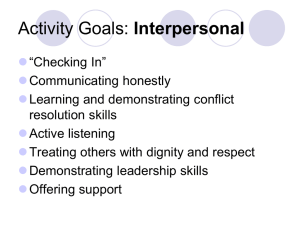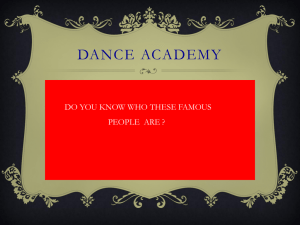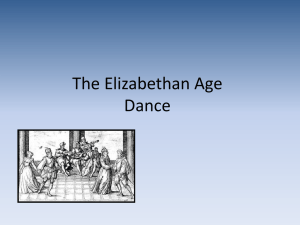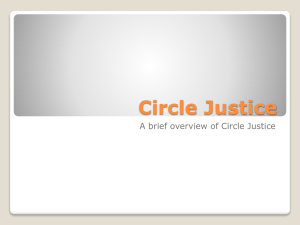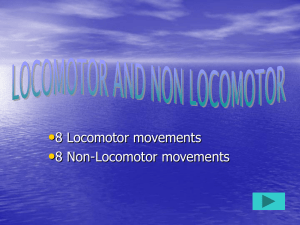Movement in the Classroom and Teaching Music
advertisement
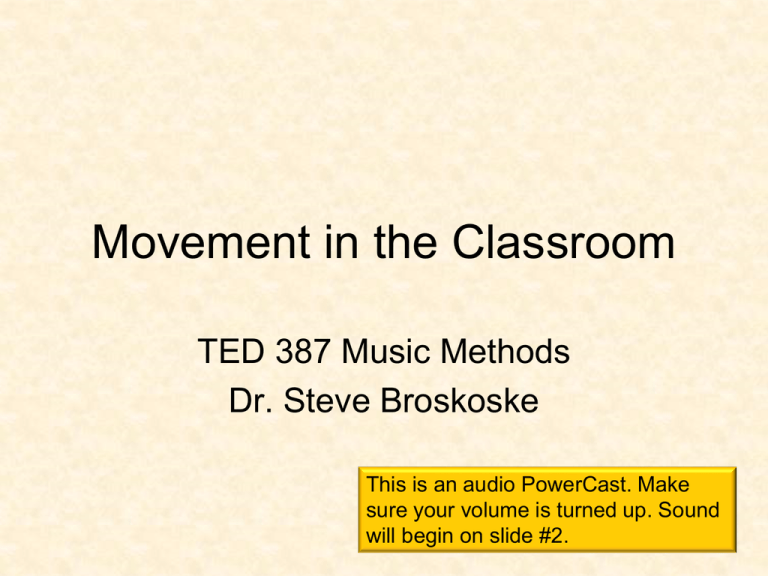
Movement in the Classroom TED 387 Music Methods Dr. Steve Broskoske This is an audio PowerCast. Make sure your volume is turned up. Sound will begin on slide #2. PA Standards for Arts & Humanities • 9.1 Know and use the elements and principles of each art form to create works in the arts and humanities. – Elements • Dance: energy/force • space • time • Music: duration • intensity • pitch • timbre – Principles: • Dance: choreography • form • genre • improvisation • style • technique • Music: composition • form • genre • harmony • rhythm • texture Benefits of Movement in the Classroom • Develop and stimulate imagination. • Understand melody, rhythm, form, harmony, texture, tempo, and dynamics. • Discover how the body can be used to create images, feelings, and moods. • Strengthen coordination of gross and fine motor skills. • Develop better awareness of balance, spatial relationships, and self-image. Preparing Environment • Ensure classroom is free of obstacles. – Move desks against walls if needed. Goals are safety & to not inhibit freedom. • Assign each child a “personal space” for safe movement. • Establish and enforce rules for these activities. Movement is Natural • Children are naturally interested in movement. To introduce movement, choose images students already know and have them act them out. – Bird flying, walking like a particular familiar animal, walking on hot ground, frogs hopping, a soldier marching. • You could also string a sequence of movements together into a story. Categories of Movement 1. Locomotor: Involve students moving from one place to another. – Walking, running, hopping, leaping, gallopping (walking & leaping), and skipping (walking & hopping). 2. Nonlocomotor: Students perform these movements from a stationary position (no moving). Nonlocomotor Five Brown Buns Five brown buns in a bakery shop. Five brown buns with sugar on the top. Along came a man with a penny in his hand, Took one bun and away he ran. Last verse: Slowly sing “no brown buns” as everyone cries. Speed up when man runs away. Nonlocomotor: Pitch 8 7 6 5 4 3 2 1 Where my hair grows On my head Past my nose Past my tummy Up on me Now he’s climbing Freddie Flea On the ground is Start here! 8 7 6 5 4 3 2 1 On my head is Freddie Flea Now he’s climbing Down on me Past my tummy Past my knee On the ground “Take that you flea!” Locomotor: Circle Games • During each verse, act out movements specified by lyrics. – Right hand, left hand, right foot, left foot, whole self, etc. Hokey Pokey Locomotor: Circle Games • Verses: Act out movements specified by lyrics. – Right hand, left hand, right foot, left foot, whole self. • Chorus: Skip around the circle, hand in hand. Looby Loo Locomotor: Circle Games • During the chorus: Students move around the circle, hand in hand. • During the verses: Stop and act out the chores described in the lyrics. • • • • • • • List of Chores Wash our clothes. Iron our clothes. Sew our clothes. Sweep our floors. Scrub our floors. Bake our bread. Go to church. Introducing Movement in Early Childhood • Establish personal space: – Have students stand with their arms extended out to their sides. Turn around in a circle while the teacher explains that this is their personal space. little-folks-music.com Introducing Movement in Early Childhood • Establish personal space: – Ask children to pretend to blow up a large bubble and get inside. Bubble represents their personal space. – Tell children to act as though they are floating around the room trying to fill up the “elephant holes” in the classroom. (Get children to move around freely without colliding into others.) little-folks-music.com Introducing Movement in Early Childhood • Experiment with walking motion: – Tap a steady drum beat. – As you tap a drum to a steady beat, walk children around an area until you stop the drum. – Lead children by repeating the movements you want them to follow. – Examples: tiptoeing, running, galloping, etc. little-folks-music.com Introducing Movement in Early Childhood • Experimenting with movement: – When the music starts, lead the children by swinging your arms, tapping your toes, bobbing your head, and shaking your hips. – Start and stop music periodically. Every time the music starts, add a new twist, bounce, or turn to get the children moving. little-folks-music.com Introducing Movement in Early Childhood • Use props: – Make streamers out of crepe paper tied onto wooden dowels. – Use scarves or ribbons. – Demonstrate movement: • • • • • Wave props high and low. Sway back and forth. Move in circles. Move prop behind your back. Ask children for suggestions. little-folks-music.com Introducing Movement in Early Childhood • Hold a parade: – Give children instruments (purchased or home-made). – Lead a parade of musical children around the playground or classroom. – Let individual children lead the parade as well. • Use movement to start the day or reenergize young learners: – Lead a series of fun stretches. – Do windmills with your arms. – Announce different movements: • Reach for the sky, tickle your toes, twirl like a top, sway like a tree, rock back and forth like a rocking chair. Dance Songs • Chicken Dance • Macarena • YMCA Circle Dances • Suitable for 2nd through 4th grades. • Serve as a transition from elementary to more complex dances performed by students in upper grades. • Dances are performed in a circle, and the lyrics suggest what movements to perform. Make sure students know a song well before learning to dance to the song. Circle Dance Old Brass Wagon 1. Circle to the left, old brass wagon. Circle to the left, old brass wagon. Circle to the left, old brass wagon. You’re the one, my darling. 2. Circle to the right… 3. Everybody in… 4. Everybody out… Folk Dances Couples do not have to be boygirl in K-6. • 3 types: – Circle dances: Dancers are in 1 large or 2 concentric circles. – Line dances: Couples come together in 2 facing lines. – Square dances: Involves 4 couples. Set Formation for line & square Folk dances allow students a nonthreatening way to explore different cultures, including our own. Folk Dance Oh, Suzanna Girls forward 4 steps Girls back 4 steps Boys forward 4 steps Boys back 4 steps Girls forward 4 steps Girls back 4 steps Boys forward 4 steps Boys back 4 steps Swing partners to right (8 counts) Swing partners to left (8 counts) Review • Dance and movement in the classroom energizes learners, and fulfills PA academic standards. • There are many benefits to using movement/dance in the classroom. • Movement can be locomotor or nonlocomotor. • Dance can be as simple as a circle dance, or more complex as a line dance.


